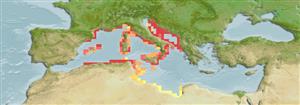>
Ophidiiformes (Cusk eels) >
Bythitidae (Livebearing brotulas)
Etymology: Grammonus: Greek, gramma = signal, mark + Greek, onos = hake.
More on author: Risso.
Environment: milieu / climate zone / depth range / distribution range
นิเวศวิทยา
เกี่ยวกับทะเล,น้ำเค็ม เกี่ยวกับหินโสโครก; ระดับความลึก 5 - 30 m. Subtropical; 47°N - 30°N, 1°E - 20°E
Eastern Atlantic: in the Mediterranean from the Balearic Islands to the Adriatic.
ขนาด / น้ำหนัก / Age
Maturity: Lm ? range ? - ? cm
Max length : 12.0 cm SL เพศผู้/กระเทย; (Ref. 4758)
Inhabits shallow rocky areas (Ref. 4758). Probably a deep dweller that migrates to coastal areas in August (Ref. 12382). Uncommon species (Ref. 34024). Nocturnal, hides in caves during the day (Ref. 12382).
Life cycle and mating behavior
Maturities | การสืบพันธุ์ | Spawnings | Egg(s) | Fecundities | ตัวอ่อน
Nielsen, J.G., D.M. Cohen, D.F. Markle and C.R. Robins, 1999. Ophidiiform fishes of the world (Order Ophidiiformes). An annotated and illustrated catalogue of pearlfishes, cusk-eels, brotulas and other ophidiiform fishes known to date. FAO Fish. Synop. 125(18):178p. Rome: FAO. (Ref. 34024)
IUCN Red List Status (Ref. 130435)
Threat to humans
Harmless
Human uses
การประมง: ไม่มีผลประโยชน์
เครื่องมือ
Special reports
Download XML
แหล่งที่มาจากอินเตอร์เน็ต
Estimates based on models
Preferred temperature (Ref.
123201): 17.4 - 20.08, mean 18.8 °C (based on 218 cells).
Phylogenetic diversity index (Ref.
82804): PD
50 = 0.5005 [Uniqueness, from 0.5 = low to 2.0 = high].
Bayesian length-weight: a=0.00457 (0.00179 - 0.01169), b=3.10 (2.87 - 3.33), in cm total length, based on LWR estimates for this (Sub)family-body shape (Ref.
93245).
ระดับชั้นอาหาร (Ref.
69278): 3.5 ±0.50 se; based on food items.
ความสามารถในการกลับคืนสู่ปกติ (Ref.
120179): ความสูง, เวลาต่ำสุดที่จะทำให้ประชากรเพิ่มขึ้นเป็น 2 เท่าใช้เวลาน้อยกว่า 15 เดือน (Preliminary K or Fecundity.).
Fishing Vulnerability (Ref.
59153): Low vulnerability (10 of 100).
Nutrients (Ref.
124155): Calcium = 41.9 [7.2, 143.0] mg/100g; Iron = 0.718 [0.253, 4.057] mg/100g; Protein = 17.9 [15.4, 20.4] %; Omega3 = 0.182 [0.077, 0.439] g/100g; Selenium = 8.15 [1.71, 26.90] μg/100g; VitaminA = 84.2 [24.3, 296.7] μg/100g; Zinc = 1.07 [0.53, 2.26] mg/100g (wet weight);
